I’ve been searching for the easiest way to turn out sticks of beautiful bread in the manner of le Francais. For I equate French breads with a gorgeous tan, exterior; a soft, chewy interior and well developed flavour.
Pain a l’ Ancienne. Bread made in the ‘old-fashioned way’.
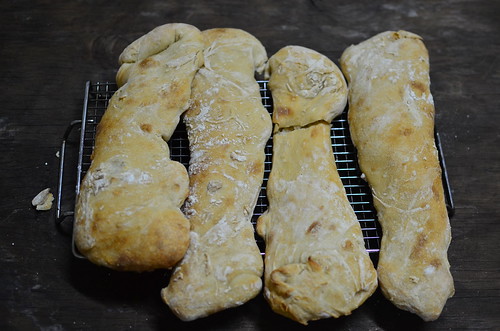
t6p says: They might look like a true baguette but pain à l’ancienne is a very different type of bread. Real baguettes rely on adding a pâte fermentée (pre-ferment, or old dough) to enhance their flavour. This means making dough you let rise overnight the day before you bake. The final dough has the pâte fermentée added in chunks. This process extends the fermentation time and increases the bread’s flavour. It’s more involved, but worth the reward. It’s how you make superior bread and impress your friends enough to maybe do the dishes.
Another difference is that baguettes are typically shaped before baking. The dough is rolled out by hand, folded length wise and then rolled back over itself. Getting that classic baguette shape and length takes a lot of practice.
Pain à l’ancienne is far simpler to make. It too is a two day bread but there’s only one dough. The shaping is also easier and more rustic. What’s really unique is this dough is made with ice water and then refrigerated overnight. I admit I don’t know a ton about baking bread, but everything I thought I did knew went out the window with this one. My typical recipes use warm water to make dough and then it’s left to rise in a warm, damp area. Overnight in the fridge?
This post is inspired in many ways by Tom Hirschfeld, a great home cook and wonderful photographer. I first ‘met’ Tom on Food52, and started reading his blog, Bona Fide Farm Food. The great ‘tip’ in this recipe is the manner in which the bread loaves are shaped, without actually ‘shaping’! You’ll see what I mean.
 Technique: Loose, wet, no-knead bread dough which begins with cold water is turned out onto a well-floured counter, covered with more flour and left to rise, before being ‘cut’ into long loaves and baked.
Technique: Loose, wet, no-knead bread dough which begins with cold water is turned out onto a well-floured counter, covered with more flour and left to rise, before being ‘cut’ into long loaves and baked.
Application: Perfect for authentic looking and tasting bread dough
Results: Great looking loaves, with beautiful texture, and taste
Level: Easy – Medium (for the ‘skill’ in transferring the dough from counter to baking tray)
Why I like it: The making of the bread dough is easy and requires no kneading. The shaping of the bread dough too is easy – no need to worry about rolling properly. The slightly tricky part is in the lifting of the dough from the work surface to the baking tray or stone.
And thanks to Tom, who wrote a post about using plastic pastry scrapers for cleaning, I remembered mine, and employed it in the lift and transfer of the dough.
My bread met with great reviews. My daughters couldn’t stop coming back for more, tearing off piece after piece till it was gone.
I have to say that I can now view myself as a ‘true’ baker, even if still an amateur one for every aspiring baker has ‘French Bread’ on their list.
Thirschfeld writes on Food52.com: I have baked bread for the family every Sunday and Wednesday now for almost ten years. I really enjoy bread and I have so many favorites it is hard to choose just one. I have begged, borrowed and stolen technique and formulas from whomever and wherever they can be found. I am buy no means the creator of this recipe. Although I have seen many different versions over the years and I am sure all have had their influence but I have to give credit to two bakers who have influenced me and this bread the most Peter Reinhart and Jeffrey Hamelman.If you want to make bread search out their books.
I used to make sourdough only but with the increase in quality flour prices it just got to expensive to feed the beast (the starter). So I looked elsewhere for flavor.
Why this bread? Because of the cold fermentation and amylase period. This creates a flavor profile that no other breads have. It is nutty and has a mild sweetness. It is a simple dough to make with a mixer fitted with a dough hook but it is very wet and not so simple to handle.
The addition of the olive oil makes the crust tender crisp not crunchy crisp. I add it because I am willing to give up the crunch for shelf life. The crumb in this is exceptionally tender.
I use a baking stone. If you don’t have one use a parchment lined sheet tray to bake the bread.
I also place an old cast iron skillet in the bottom of the oven to create steam.
The first time I made the bread, I added olive oil but the second time, I went the pure route and kept it simple with 4 ingredients – water, salt, yeast and flour. I also left the dough for four days before I could bake it – life et al got in the way. The resulting dough had a real tang, and good texture. It featured in my open-faced sandwich with Wara
My recipe: Bread, in the manner of Pain a l’Ancienne
Makes 4 loaves
Ingredients
3 cups cold water 2 teaspoons salt 1 tablespoon instant yeast (apparently active dry yeast doesn’t work with the cold water and rise) 6 cups plain/all-purpose flour (4 cups for dough, 2 cups reserved for the counter on the day of baking)Directions
Step 1: Mix the dough
In keeping with our no-knead theme here on Kitchen Butterfly, combine the water and salt, then add 4 cups of flour and finish by sprinkling the instant yeast on top.
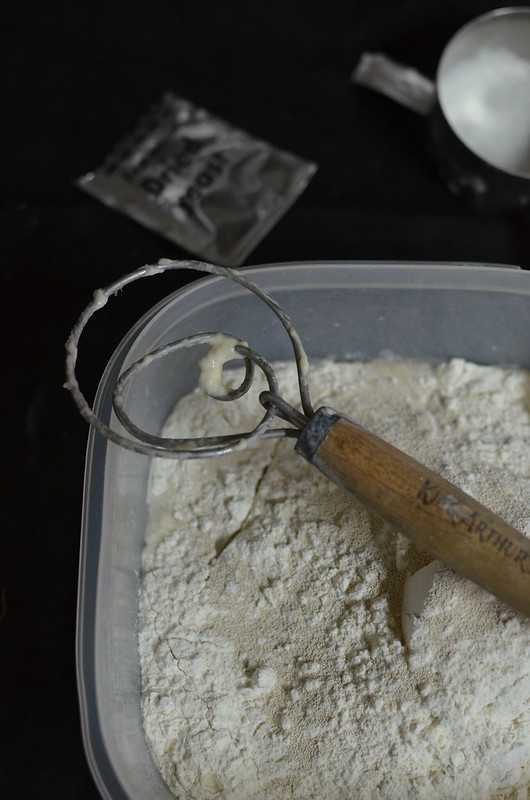
Using a wooden spoon or a dough whisk, slowly combine the ingredients till a sticky dough is formed. Cover with greased clingfilm and refrigerate for at least 24 hours and up to 4 days. Note that the longer you leave the dough, the more sour the flavours will get. At four days, you’ll have well-developed ‘sourdough’ flavour.
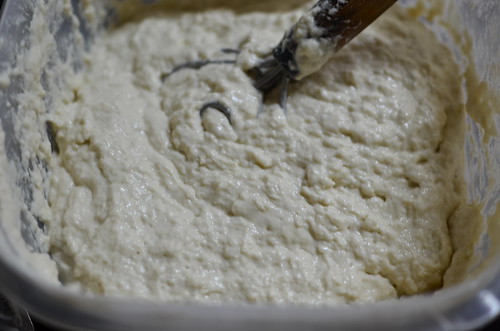
Step 2: Shape the loaves
Remove the dough from the fridge 2 hours before you’re ready to bake it.
Sprinkle the counter with a 1 & 1/2 cups of flour, turn the dough onto it and with floured hands, shape the dough into a 12 by 12 inch square (about 30cm X 30cm).
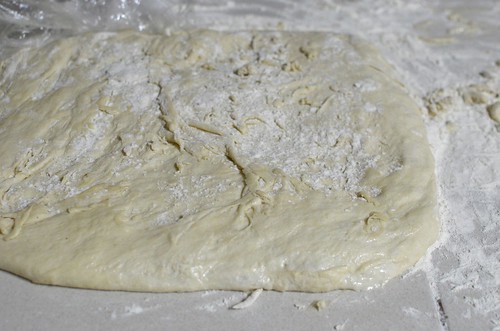
Sprinkle the remaining 1/2 cup of flour over the dough.
Grease a large piece of cling film and lay it over the dough to cover it. Allow to rise for at least 1 & 1/2 hours.
Step 3: Bake the loaves
Pre-heat the oven to 250 deg C (500 deg F) when you have 15 minutes left to the end of the bread rise. If using a pizza stone, place it on the middle rack, and allow to heat up. If not, set out a baking sheet. To develop great crispy crust, put a skillet at the base of the oven, filled halfway with water – if it cooks down, you can add more hot water later on.
Prepare 4 strips of parchment large enough to take the dough, which will be cut into 4.
Gently lift away the cling film. Then using a dough scraper, portion out the dough into 4, moving the cutter from side-to-side while cutting to separate the strips.
The next step involves transferring the dough from the worktop to a pizza peel or onto the baking tray.
This can be tricky but I employ the services of my dough scraper. With my left hand, I cradle the dough and with the right, and the dough scraper, I gently lift the dough, both hands get the dough on the tray. Sometimes, the dough gets ‘accordion-folded’ with the action of the scraper but gently so.
Once the dough is safely set on parchment, stretch it back gently to its former length.
The base of the bread will be ‘crusted’ with flour, a reminder of its time on the counter.
For the pizza stone, fit as many strips of dough onto your peel as your oven can manage. Slide the dough on parchment from the peel unto the baking stone by pushing your hand forward and quickly pulling it back so the dough+parchment come off the peel. (Kind of like pulling a rug – the peel) out from under someone’s feet – the dough).
For the baking sheet, fit as many strips of dough onto your peel as your oven can manage.
Carefully, but quickly, add ice-cubes into the skillet filled with hot water and shut the door.
Turn the heat down to 220 deg C (450 deg F) and set a timer for 14- 18 minutes during which the door should not be opened.
When the timer goes off, gently turn the bread/baking tray 180 degrees around, and bake for an additional 5 – 6 minutes then remove to a rack to cool.
Once cool enjoy on its own, or in an open-faced sandwich
Would you use this technique? Have you come across it before?
[wpurp-searchable-recipe]Technique: How to Bake Authentic French Bread, Pain a l’ Ancienne – – – [/wpurp-searchable-recipe]





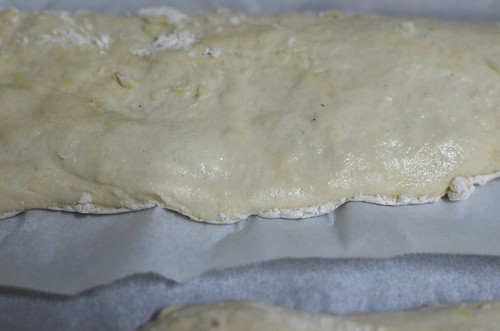
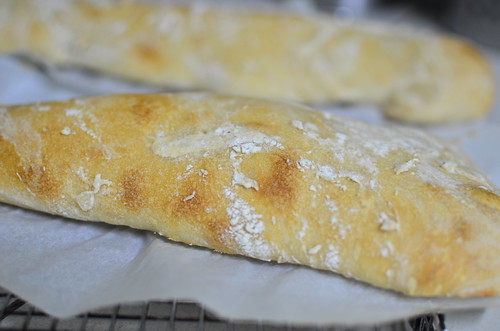
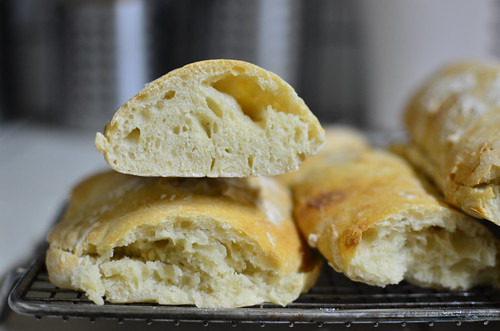
Leave a Reply